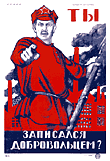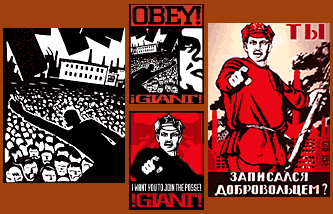 "Graphic, bright and compelling, soviet posters are often viewed as the quintessence of an epoch, reflecting the way that the country's rulers addressed the governed. Through the images of posters, the audiences can see how the state encouraged people, and what it did to make them feel optimistic about their future.
"Graphic, bright and compelling, soviet posters are often viewed as the quintessence of an epoch, reflecting the way that the country's rulers addressed the governed. Through the images of posters, the audiences can see how the state encouraged people, and what it did to make them feel optimistic about their future.The first Russian political posters date back to the Napoleonic wars, but they gained an international fame during the 1920s when avant-garde artists Kazimir Malevich, Aristarkh Lentulov and Alexander Rodchenko became interested in the genre. Indeed, the first Soviet propaganda posters were created by some of the most talented and acclaimed artists in the country.
Communism's "spin doctors" waged a tireless struggle to win the hearts and minds of the masses, and no object was too insignificant for them. They made ink pots in the shape of a woman reading Stalin's historical works or embroidering a Soviet flag. They made tea sets portraying heroic revolutionary leaders - and, of course, they went for capitalist Russia's favorite technique of hanging huge banners over main thoroughfares - except that instead of promoting the fun of the casino as those on Nevsky Prospekt do today, they extolled the virtues of the workers of the world.
 Such propaganda techniques were especially important during the first years of the revolution, when the authorities were appealing to the whole nation. Propagandists and political technologists had to transform the mentality of the people and make them accept new political ideas and a new lifestyle. In that respect, this mentality very much bridges them with authors of modern advertising campaigns who attempt to change people's habits and encourage them to try new products.
Such propaganda techniques were especially important during the first years of the revolution, when the authorities were appealing to the whole nation. Propagandists and political technologists had to transform the mentality of the people and make them accept new political ideas and a new lifestyle. In that respect, this mentality very much bridges them with authors of modern advertising campaigns who attempt to change people's habits and encourage them to try new products.In contrast to our times, during the 20th century most Soviet artists didn't shrug away from politics. "Nobody has made any known statements about hating to do posters. It was quite the opposite, the artists were finding these tasks challenging and exciting as it was a thrilling chance to speak directly to thousands of people. Malevich, for instance, started with political posters but eventually turned away." Soviet Poster A Day
Could I incorporate this into the project?













No comments:
Post a Comment